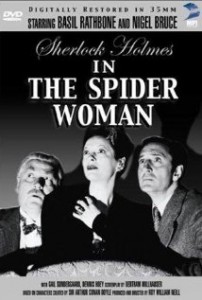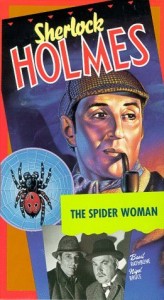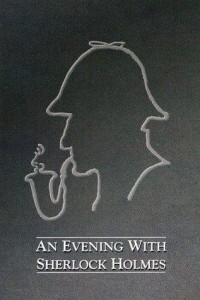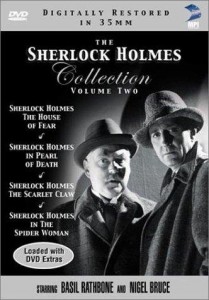The Spider Woman ***½ (1943, Basil Rathbone, Nigel Bruce, Gale Sondergaard, Dennis Hoey, Mary Gordon) – Classic Movie Review 1,027
The thoroughly enjoyable 1943 mystery film The Spider Woman sees Basil Rathbone’s Sherlock Holmes investigating the ‘pajama suicides’ case. Gale Sondergaard’s Adrea Spedding proves a worthy adversary.
‘I’m so sorry we have nothing in the house for burns. I so seldom get burned.’ – Adrea Spedding (Gale Sondergaard).
Director Roy William Neill’s thoroughly enjoyable 1943 mystery film The Spider Woman sees Basil Rathbone’s Sherlock Holmes investigating a case that the press has dubbed the ‘pajama suicides’. It’s the seventh of Basil Rathbone and Nigel Bruce’s 14 films based on Sir Arthur Conan Doyle’s detective and the fifth in Universal’s updated World War Two series of 12.
Alternatively titled Sherlock Holmes and the Spider Woman, the film is set in then-present day as opposed to the Victorian setting of the original stories, as with all of the Universal Studios films in the series. The screenplay by Bertram Millhauser has an original plot but mixes in elements from the 1890 Arthur Conan Doyle novel The Sign of the Four, as well as Conan Doyle’s short stories The Final Problem, The Adventure of the Empty House and The Adventure of the Speckled Band, and refers explicitly to The Adventure of the Devil’s Foot.
Eminent, wealthy men are going to bed in the safety of their own homes but commit suicide in the night. He is convinced that a woman villain he describes as ‘a female Moriarty’ is behind the deaths – as cunning as Moriarty and as venomous as a spider.
Holmes fakes his own death and impersonates a rich retired Indian military officer to flush the woman out and he soon meets Adrea Spedding (Gale Sondergaard). She susses him out and sets him up in a carnival shooting gallery to meet his death.
La Spedding proves a worthy adversary, as even Holmes admits to Nigel Bruce’s Dr Watson: ‘If you ever see me getting too sure again, fancying myself more clever than Adrea Spedding, just whisper one word to me: “pygmy”.’ Sondergaard is outstanding, crackling in her scenes with Rathbone, and among the film’s other pleasures are Dennis Hoey’s Inspector Lestrade and Mary Gordon’s Mrs Hudson.
Adam Gilflower (Arthur Hohl) is summoned by Holmes to identify the dead spider because, says Holmes: ‘I believe you know more about spiders than any man in London.’ Gilflower identifies the spider, but incorrectly observes that it is ‘the deadliest insect known to science.’
Puzzlingly, even Holmes (or the screenwriters) gets things wrong. When the impostor posing as Matthew Ordway knocks a terrarium of black widow spiders on to the floor and Watson reaches for the gun among them, Holmes shouts: ‘Stop it, Watson! Those insects are deadly!’ Spiders are arachnids with eight legs and two body segments unlike insects that are six-legged and have three body segments. And Holmes has revealed the man to be an impostor because of his ignorance of spiders!
It was released on December 10, 1943.
The Spider Woman is preceded by Sherlock Holmes Faces Death and followed by The Scarlet Claw.
Sondergaard was very popular and the inevitable follow-up ensued, The Spider Woman Strikes Back (1946), but it has no relation to The Spider Woman, with Sondergaard playing a completely different character. A series was hoped for by Universal, but it didn’t happen.
The cast are Basil Rathbone as Sherlock Holmes, Nigel Bruce as Dr John Watson, Gale Sondergaard as Adrea Spedding, Vernon Downing as Norman Locke, Dennis Hoey as Inspector Lestrade, Alec Craig as Radlik, Arthur Hohl as Adam Gilflower, Mary Gordon as Mrs. Hudson, Teddy Infuhr as Larry, Angelo Rossitto as The Pygmy, Harry Cording as Fred Garvin, and Robert Milasch as Carnival Barker.
As it was filmed in World War Two, the moving targets in the shooting gallery are cartoons of Hitler, Mussolini and Hirohito, but the previous 1943 entry Sherlock Holmes Faces Death was a welcome return to the pure mystery film genre, and succeeding sequels played down their wartime propaganda elements.
The Rathbone–Bruce series consists of: The Hound of the Baskervilles (1939), The Adventures of Sherlock Holmes (1939), Sherlock Holmes and the Voice of Terror (1942), Sherlock Holmes and the Secret Weapon (1942), Sherlock Holmes in Washington (1943), Sherlock Holmes Faces Death (1943), The Spider Woman (1943), The Scarlet Claw (1944), The Pearl of Death (1944), The House of Fear (1945), The Woman in Green (1945), Pursuit to Algiers (1945), Terror by Night (1946), and Dressed to Kill (1946).
http://derekwinnert.com/the-scarlet-claw-1944-basil-rathbone-nigel-bruce-classic-film-review-1026/
© Derek Winnert 2014 Classic Film Review 1,027 derekwinnert.com








